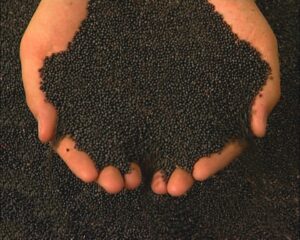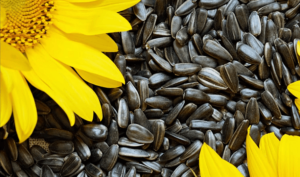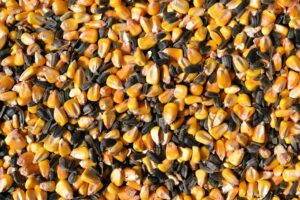
Corteva Agriscience, an international agricultural research company, increased organic sales of sunflower seeds and winter rapeseed by 30% and 80%, respectively, in 2023 compared to 2022, its press service reports.
According to the press release, despite the reduction of corn acreage in Ukraine due to the military actions, Corteva increased its presence in the farms that continued to grow this legume.
The company’s sales growth was driven by an effective direct model of cooperation with farmers, an extensive network of sales agents and representatives, and comprehensive agronomic support for farmers throughout Ukraine. In addition, Corteva has partnered with the Howard G. Buffett Foundation to provide additional rapeseed, corn and sunflower seeds for planting to small Ukrainian farmers in the affected areas, the company said.
Corteva also reported that, despite the overall decline in the crop protection market in Ukraine, the company’s organic sales in 2023 increased by 13% compared to last year. At the same time, the demand for Corteva insecticides doubled compared to 2022.
“Such results reflect the company’s focus on providing farmers with the latest and most advanced products to increase agricultural productivity in Ukraine, as declared in the joint declaration between Corteva Agriculture and the Ministry of Agrarian Policy and Food of Ukraine on deepening and further developing cooperation for food security in Ukraine and the world,” the statement said.
“Almost two years after the start of the full-scale war, we at Corteva have been working side by side with Ukrainian farmers to help them meet the new challenges they face. We have transformed the company’s work in accordance with the current conditions and learned to work in marathon mode. Farmers consider us to be their reliable partners, which is evidenced by the fact that the number of customers remains unchanged despite the overall market contraction. Our team is doing everything possible, demonstrating extraordinary dynamics in 2024,” said Oleksandr Dmytriyev, Corteva Agriscience’s business manager in Ukraine.
As reported, the world’s leading agrochemical company’s operating EBITDA in 2023 increased by 5% year-on-year, while operating profit per share increased by 1% over the same period.
Corteva Agriscience forecasts that in 2024 its net sales will be in the range of $17.4-17.7 billion and operating EBITDA in the range of $3.5-3.7 billion.
Corteva Agriculture is a global agricultural company. It offers comprehensive solutions to maximize yields and profitability. It has more than 150 research facilities and more than 65 active ingredients in its portfolio.
The company’s presence in Ukraine includes the headquarters in Kyiv, a research center in Liubarky (Kyiv region) and a seed production complex in Stasi (Poltava region).
In April 2022, the company decided to leave the Russian market due to the full-scale war against Ukraine unleashed by Russia.

The Cabinet of Ministers has simplified the conditions for exporting sunflower seeds to Bulgaria and established an automatic licensing regime instead of a non-automatic one.
According to the official website of the government, the decision was made at the meeting of the Cabinet of Ministers on Friday.
“Recently, the Republic of Bulgaria has agreed to liberalize the export licensing regime for one of these agricultural commodities, namely sunflower seeds. From now on, obtaining licenses to export sunflower seeds to Bulgaria will not require the approval of the Ministry of Agrarian Policy and, accordingly, separate consultations with this country,” the press service of the Cabinet of Ministers quoted Taras Kachka, Deputy Minister of Economy of Ukraine – Trade Representative, as saying.
According to him, this should simplify the export of relevant Ukrainian products.
Earlier, in order to unblock Ukrainian exports of agricultural products through neighboring EU countries, the government introduced verification and approval (licensing – IF-U) of wheat, corn, rapeseed and sunflower exports to Bulgaria, Romania, Slovakia, Hungary and Poland.

Spain is ready to promote Ukrainian agricultural exports and is interested in importing Ukrainian agricultural products, in particular corn and sunflower, Spanish Minister of Agriculture, Fisheries and Food Luis Planas Puigades said at an online meeting with Ukrainian Minister of Agrarian Policy and Food Mykola Solsky on Monday.
According to the press service of the Ministry of Agrarian Policy, during the online meeting, the parties discussed the export of Ukrainian agricultural products and food security. In particular, the extension of Ukraine’s duty-free and quota-free trade regime with the European Union.
“Spain fully supports Ukraine in the face of Russia’s unprecedented and illegal aggression. This includes both military and humanitarian assistance. The Spanish Minister of Agriculture emphasized that support for Ukraine also means promoting Ukrainian exports, which is a key factor for the economy to continue to function,” the Ministry of Agriculture said, adding that Spain is interested in importing Ukrainian agricultural products, in particular corn and sunflower.
“I reaffirmed Spain’s support for the continuation of trade measures to support Ukraine during a video conference with the Minister of Agrarian Policy and Food of Ukraine. Ukrainian farmers have managed to maintain production despite the difficulties,” Puigadez wrote on the social network X after the talks.
For his part, Solsky thanked his Spanish colleague for his understanding and support.

“Kernel, one of Ukraine’s largest agricultural holdings, processed 811 thsd tonnes of sunflower seeds in the second quarter of fiscal year (FY) 2024, up 24% year-on-year, when the company’s operations were disrupted by power outages due to Russia’s attacks on Ukraine’s energy infrastructure.
“Two out of eight plants of the agricultural holding, which are located in Kharkiv region near the border with Russia, remain unavailable for work,” the company said in a financial report on its website on Monday.
According to the report, sales of sunflower oil in the second quarter of FY2024 increased by 13% compared to the same period last year and exceeded 388 thousand tons. High volumes of sunflower seeds processing are supported by various export logistics options, including deep-water Ukrainian Black Sea ports. At the same time, sales of bottled sunflower oil accounted for 6% of total sales.
In the first half of FY2024, Kernel’s elevator volumes increased by 21% year-on-year to 2.5 mln tonnes as the agricultural holding managed to complete the harvesting campaign in its Agriculture division on time, unlike the postponed harvesting campaign a year earlier.
According to the agroholding, it managed to increase export transshipment volumes through its terminals by 11.2 times in October-December 2023, up to 1,805 thousand tons, using the temporary commercial shipping corridor created by the Ukrainian Navy. This volume includes transshipment of grain, sunflower oil and meal, as well as transshipment services provided to third parties (65 thousand tons in the second quarter of FY2024).
This figure, according to Kernel, is 5% higher than the same period last year and is explained by the success of the agricultural holding, which was achieved during FY2023 as part of the Black Sea Grain Initiative.
However, export terminals operated below pre-war levels as they suffered from damage caused by Russian missile strikes on Kernel’s port infrastructure in the summer of 2023.
Due to the resumption of transshipment volumes at the export terminal, the volume of grain exports from Ukraine in the second quarter of FY 2024 increased 8.4 times compared to the previous quarter, reaching 1.705 thousand tons, the agricultural holding stated.
As reported, before the war, Kernel was the world’s largest producer of sunflower oil (about 7% of world production) and its exports (about 12%). It is one of the largest producers and sellers of bottled oil in Ukraine. It is also engaged in the cultivation and sale of agricultural products.
In the first quarter of FY2024, the company posted a net loss of $30.9 million, while the previous year ended with a net profit of $162 million, with revenue down 17% to $564 million.

Bulgaria has authorized licensed imports of Ukrainian sunflower, rapeseed, corn and wheat, according to the website of the Ministry of Agriculture and Food of Bulgaria.
According to the report, during an online meeting on Friday, the Ministers of Agriculture of Bulgaria and Ukraine Kirill Vatev and Nikolay Solsky agreed to implement a licensed export regime for sunflower, rapeseed, corn and wheat seeds and agreed on the details of its application.
“The Ministry of Agriculture and Food has kept its promise to limit imports of these agricultural products as much as possible until November 30, according to the Memorandum signed between the government and the Initiative Committee of Protesting Farmers,” the Bulgarian ministry quoted Minister Vatev as saying.
He emphasized that after this period, the two countries will “strictly monitor that there are no market distortions and that the interests of Bulgarian producers, processors and consumers are not undermined.”
Imports and data exchange between the two countries will continue, the Bulgarian ministry emphasized.
As reported, in November 2023, the Minister of Agrarian Policy of Ukraine Solsky expressed the opinion that Bulgaria, which refrained from imposing a unilateral ban after September 15, could become the first frontline country to lift the ban on Ukrainian agricultural products.
In his opinion, the crop that Bulgaria will be ready to import from Ukraine will be sunflower. In Bulgaria, in the fall of 2023, a compromise was reached between farmers and processors to open the market for imports of Ukrainian sunflower from December 1. By this time, local sunflower oil producers, according to the Bulgarian government, will have to buy back the sunflower seeds produced by farmers, and they will need an additional 1.5 million tons of raw materials.
Earlier, Stepan Kapshuk, head of the industry association Ukroliyaprom, told Interfax-Ukraine that Bulgaria has 16 oil extraction plants that have significantly increased production in the 2022 season and intend to develop sunflower oil exports using sunflower seeds imported from Ukraine.
On September 15, the European Commission announced that it would not extend the restrictions on imports of agricultural products from Ukraine to five neighboring EU countries (Poland, Bulgaria, Hungary, Romania, and Slovakia) under certain conditions that will help avoid a new sharp increase in supplies.
The restrictions were introduced on May 2, 2023, and applied to imports of wheat, rapeseed, sunflower, and corn. These five Eastern European EU member states argued that Ukrainian agricultural products, when imported duty-free into the EU, were being deposited in their countries and were harming their local agricultural sectors.
After the restrictions were lifted, Poland, Hungary, and Slovakia imposed unilateral bans. Poland expanded its list of banned products to include rapeseed cake and meal, as well as corn bran, wheat flour, and derivatives. Hungary extended the list to 24 commodity items.
Ukraine filed a lawsuit with the WTO, accusing Poland, Hungary, and Slovakia of discriminatory treatment of its agricultural products.
Ukraine is currently negotiating a mechanism for licensing exports of Ukrainian agricultural products with mandatory verification in each of the five countries.

One of the largest grain market operators in Ukraine, JV Nibulon LLC (Mykolaiv), has signed an agreement with German agricultural machinery manufacturer HORSCH to purchase 13 seeders for sowing corn, rapeseed and sunflower at the AGRITECHNICA-2023 exhibition in Hannover.
“HORSCH Maestro seed drills are among the best and most technologically advanced on the sowing equipment market. They are convenient and productive, and their high sowing accuracy will allow us to perform operations efficiently and quickly at operating speeds of up to 15 km/h,” the company wrote on Facebook.
Nibulon explained its choice by the constant improvement of the machines by the manufacturer, testing on a production scale, including in Ukraine. In addition, HORSCH has a well-developed service base in Ukraine, which allows it to operate and maintain equipment with minimal downtime.
“We are striving to optimize our production processes and improve the quality and productivity of sowing to a new level,” Nibulon summarized and thanked HORSCH for its cooperation.
As reported, Nibulon also signed an agreement to purchase 29 agricultural machines with German agricultural machinery manufacturer CLAAS at AGRITECHNICA-2023. It is planned that 10 combines, 15 tractors and 4 telescopic loaders will be used for crop production in the 2024 season.
Nibulon JV LLC was established in 1991. Prior to the Russian military invasion, the grain trader had 27 transshipment terminals and crop reception complexes, a one-time storage capacity of 2.25 million tons of agricultural products, a fleet of 83 vessels (including 23 tugs), and owned the Mykolaiv Shipyard.
“Before the war, Nibulon cultivated 82 thousand hectares of land in 12 regions of Ukraine and exported agricultural products to more than 70 countries.
In 2021, the grain trader exported the highest ever 5.64 million tons of agricultural products, reaching record volumes of supplies to foreign markets in August – 0.7 million tons, in the fourth quarter – 1.88 million tons, and in the second half of the year – 3.71 million tons.
Nibulon’s losses from Russia’s full-scale military invasion reached $400 million. The grain trader is currently operating at 30% of capacity and has set up a special unit to clear agricultural land of mines.